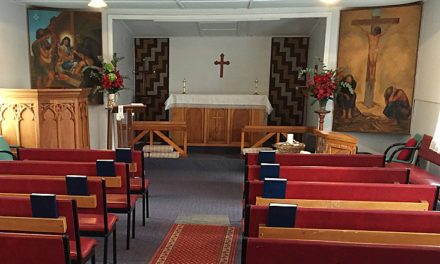The Wellbeing Imperative
This month’s whakataukī (proverb) is: “He whiro rānei koe, he ahurangi rānei?” (“Are you an evil person, or one of good character?”). Tohunga (Māori priests) used to ask this of initiates seeking to undergo purification rites. The answer from the young and confident was inevitably “I’m good!”. It is safe to assume the wise old elder looked on and thought, “nah!”. The cocky initiate had no clue what it meant to be ahurangi, a virtuous person; they had not yet been tested enough by life to warrant such confidence. We are all in the shaping, yet we must never forget that we come from healthy root-stock. God created a’dam (humans, ‘of the ground’, from which we derive our concept ‘indigenous’) in God’s image and declared us to be “good!”
My early Christian life and discipleship formation in my late teens, within a non-denominational back-country charismatic Christian fellowship, contained a good dose of unquestioned theology. This was further reinforced by teaching I was exposed to when I moved to a big city church and participated in the urban youth group movement. As a new believer I just accepted everything I was told, as you do. It has served me well as a foundation and I still embrace the essentials, but as I’ve grown and sat under different teachers, so I have found cause to re-evaluate some of that early discipling.
I was challenged on one element of unquestioned theology when I was 30 years old. Let’s just say I was ‘educated’ by Dr Christopher J. H. Wright when I disagreed with him in a tutorial session, seeking to defend a rather extreme understanding of the total depravity of human beings. I lost. But it wasn’t his Old Testament scholarly apologetic that helped me ‘see the light’, it was the genuine compassion in his instruction as he looked at me with deep concern and asked me to consider the implications of such a belief. I was well and truly schooled, and that encounter was so rupturing that it set me on a very different trajectory for my MA studies than the one I enrolled to do. My research was still focused on better understanding missions mobilisation, but I was to gradually shift from a pathological view of missions (focusing on a disease) to a wellbeing perspective. This continued to develop in my practice as a missions leader and on into my doctoral research.
I have found that a pathological focus is ultimately unhelpful for missions. It tends to amplify what is wrong with a person, group or nation. It sets the missionary in the superior role of a clinician (a judgmental position) tasked with diagnosing and ‘fixing’ the identified problem.
One might think that the former (disease) is cause to which the latter (wellbeing) is the result of a right application of a healing remedy. But I have found that a pathological focus is ultimately unhelpful for missions. It tends to amplify what is wrong with a person, group or nation. It sets the missionary in the superior role of a clinician (a judgmental position) tasked with diagnosing and ‘fixing’ the identified problem. The remedy is usually via some formulaic methodology, resulting from a pragmatic solution found in one context and not necessarily well adapted to others. Pathological missiology too easily cherry picks scientific theory to try to right what is perceived to be wrong with the world (e.g. outdated or faddish anthropological, sociological, political, or psychological theories).
Wellbeing missiology, on the other hand, looks for the representation of the “good” in our ministry contexts and focuses on amplifying those. “Good” is based on biblical aspirations of what healthy relationships ought to be. We see all kinds of examples of good throughout Scripture, we are called to do good in the world, and we are encouraged to understand what God’s good (pleasing and perfect) will is for us as God’s people. God is good, and reintegrated with God in-Christ is where we reclaim our good. The world of social development has been focused on identifying good for decades, yet it doesn’t seem to have made much of an impact on the traditional missions community (of the evangelism, discipleship, and church planting kind). One form this takes in the social development realm is “asset based community development” (ABCD). Look for the good, rally the community, seek solutions from within, and support those solutions (in close collaboration with the locals) from without.
Another shift from pathology to wellbeing is seen in the area of positive psychology. Traditional psychoanalysis is almost obsessively pathological, treating mental and emotional health from a deficiency perspective. Since the 1950’s a wellbeing-focused offshoot of psychology has preferred to put energy into strengthening our relational health to help resolve dissonance we experience in our inner psyche. It’s not that we ignore problems, but that we find hope elsewhere—in a healthy reliance on others (faith), belief that things will improve (hope), and investment of our agency in fostering that improvement (love). An increasingly popular approach to this is known as attachment theory and it’s providing us with some wonderful new language to articulate our restored relationships with God, others, and our habitats, through Christ’s death and resurrection, enabled by the Holy Spirit, to demonstrate new creation. Our declaration of the gospel fails to fully represent our witness without such a demonstration. Mission then should flow from a compulsion to live out the fulness of who we are created to be, individually and collectively for the benefit of all.
I have come a long way in my thinking about the inherent goodness of humanity (yes, deeply affected by sin, and secular humanitarianism cannot provide long-term solutions, but that’s another conversation). We need to better orient ourselves to our higher calling, to embrace and live out fulness of life now that we are in-Christ. I was reminded of this afresh as I participated in a communion service at an international missions gathering. I couldn’t sing the verses of the song chosen for the occasion, a 2010 revitalisation of Joseph Hart’s eighteenth century hymn “Pity A Helpless Sinner Lord”. It included lines like, “I’m a sinner vile indeed”, “a sink of sin and unbelief”, “can there be… room for me?” Oh, sure, I understand the sentiment and the era of piety from which it was written, but such a pathological perspective surely belongs on the other side of the cross—among the unredeemed. It is from this very uncertainty and shame that we are rescued, is it not? That is the good news. We need no longer wallow in doubt that our deliverance is secure. Not believing so would be similar to the backslider in Hebrews 6:4-6 who is accused of nailing Christ to the cross all over again.
We are free. Let that revelation set in. Our witness, then, is to demonstrate it to the world and show people of every nation, tribe, and language the way to access this freedom. Not a transfer of legalistic bondage, but emancipation found in a restored intimate relationship with our Creator—part of a new “integrated singularity” (indivisible oneness) with God in-Christ, as Jesus prays in John 17:18-26. But how do we usually seek to motivate people (young people) to join us in this grand purpose?
With most younger people today, exclusivity is the greatest of all the (social) sins.
In my experience, it is to focus on the bondage of others (as captured by the dark, evil, wicked, unredeemable cultures that hold them fast), and implicitly call for ‘champions’ like knights in shining armour on a great quest. This is pathological. Its starting point is one of disease and exclusion. Trouble is, with most younger people today, exclusivity is the greatest of all the (social) sins. So, is it any wonder that our traditional motivational methods are falling on deaf ears? What if we flipped the script, and articulated a narrative of desirable inclusion? Focus on the wellbeing we (should) experience in-Christ and lament the fact that one third of the world doesn’t even know that such freedom, belonging, and intimacy with a loving God is available. Access still requires penitent allegiance to Christ, but it’s one motivated by the benefits on the other side more than whatever we think the disease is. They will know only too well.
Apparently the tohunga didn’t correct young initiates’ confident responses. That wasn’t the tohunga’s job. The larger community reflects back to a person what kind of person they are. If evil—which I define as relationally destructive—then there are consequences. The tohunga’s role was to prepare the initiate for the purification rite, conduct the rite, and trust the process to sort out the rest. Regardless our opinion of other purification rights, our rite of passage into new creation is not so different. Our starting answer to the question might be that we are in some self-determined way ‘evil’, for contrition requires that of us. But on confessing our allegiance to Christ and repenting of those old ways, every initiate (disciple) steps into new creation anew.
We are accepted as good, and our responsibility thereon is to live accordingly, as the Holy Spirit and the holy community of God’s people sort out the rest. Something like this reorientation, from pathology to wellbeing, needs to capture us if we want to find ourselves fruitful in the increasingly complex and pluralistic world we are seeking to witness to, as we #stayonmission.
Arohanui ki a koutou e haere ana ki te ao (love to you all as you go into the world),
Jay






